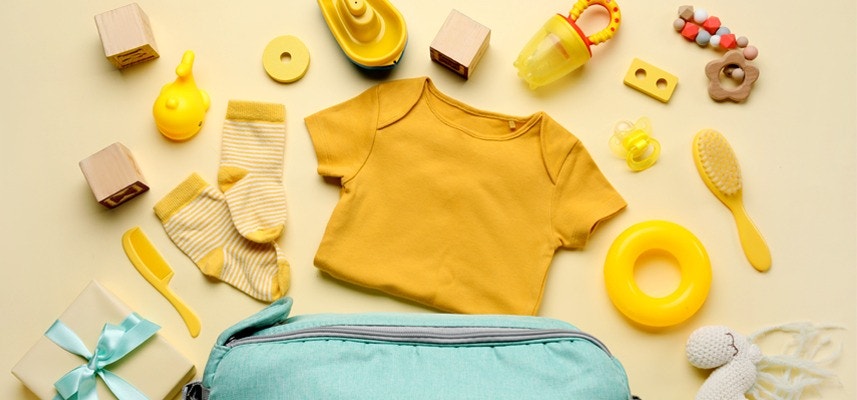Keys. Lunch. Laptop. Breast pump.
Returning to work after having a baby can mean pumping at the office, and since you’ll likely be away from your baby for two to three feedings, this means ensuring your work environment is set up to accommodate you. Below, we’ll discuss the importance of pumping at work, which generally allows employees to maintain milk production and feeding schedules at home, build up their breast milk supply, and relieve pressure or discomfort in breasts.
Breastfeeding mothers also see faster rates of postpartum healing, stronger maternal bonds with their babies, and additional health benefits, including lower rates of high blood pressure, heart disease, diabetes, and more. Breast milk is easier on your baby's digestive system, has all of the nutrients, vitamins, fats, and proteins your baby needs, and even has antibodies to help keep them healthy. Breastfed babies also have reduced risks of ear infections, eczema, asthma, cancer, allergies, and more—some of these health benefits last their whole lifetime! They call it liquid gold for a reason.
Even when you’re prepared, you might still have questions about where to pump, how often you can pump, what is considered an adequate break time, and what accommodations you can expect. This article will discuss your rights to pumping at work and breastfeeding in public, sharing advice for both.
Your Right to Breastfeed in Public
Recent data shows both progress and persistent challenges for breastfeeding mothers in the workplace. In good news, according to Aeroflow Breastpumps' 2024 national survey, 85% of working mothers believe their employers' maternity plans will meet their family's needs—a significant improvement from 73% in 2018! Additionally, 69% of working mothers now have workplace pumping policies and have discussed them with HR or supervisors, representing a 20% increase over the past six years.
However, challenges remain. Despite the PUMP Act being in effect for over a year, 83% of mothers still experience workplace stigma around pumping—an increase of 20% compared to 2018. Additionally, 54% of working mothers have considered changing jobs due to their employer's pumping policies, and 44% report negative interactions with coworkers about pumping. These statistics underscore the importance of understanding and advocating for your breastfeeding rights.
While 75% of working mothers now have access to private pumping spaces at work, 82% believe their employers could provide more support and resources to help balance breast pumping and workload. Perhaps most concerning, 59% of mothers worry about how breastfeeding and pumping might impact their career growth—an increase from 2018 when less than half expressed this concern.
Benefits for Employers
Did you know that there are many benefits for employers who support their breastfeeding mothers? Research shows that providing a lactation support program and facilities for breastfeeding or pumping is not only highly desired by those who return to work after childbirth, but it can also improve job satisfaction and your company’s ROI by decreasing employee turnover rates and saving money in health care costs and employee expenses.
Understanding Breastfeeding Laws


But what does this mean for you as a breastfeeding mother returning to the workplace? Understanding your breastfeeding rights now will prepare you for future conversations around the benefits employers can reap from improving their maternity and lactation policies. From finding public accommodations and dedicated lactation spaces to ensuring you have all of your equipment, deciding if you’re comfortable with public breastfeeding depends on several factors, many of which aren’t under your control.
You have a legal right to breastfeed in public. The United States protects the right to breastfeed in public and private spaces, including businesses, airports, and other areas. The law also requires certain public spaces to provide a hygienic, shielded space—other than a restroom—to breastfeed. This space must include a place to sit, a working surface, and an electrical outlet to express milk.
Additionally, employers must provide workers with reasonable time to express milk up to one year after a child’s birth. But even with these protections in place, some people may find it difficult to find lactation rooms or face uncomfortable comments from strangers.
Here are a few tips for breastfeeding in public:
Tips for Breastfeeding in Public
-
Understand your rights. Find more information about your right to breastfeed in public by researching your state’s laws.
-
Plan ahead when possible. Finding a list of places with adequate breastfeeding spaces is critical when out and about. If you know you’ll be in a certain area for an extended period, research nearby shops, restaurants, and businesses that will support breastfeeding, expressing milk, and changing babies.
-
Dress for success. Nursing bras and tops are popular breastfeeding apparel, but you can branch out by wearing any type of clothing that provides your baby easy access to your breast for feeding.
-
Invest in wraps, slings, or carriers. These items are not only designed to make breastfeeding easier wherever you are, but they also provide your baby direct access to your breast, free up your hands for other activities, and offer coverage and privacy when nursing rooms are unavailable.
-
Prepare with pre-pumped milk. It may not always be possible to pump and carry milk with you, but for times when you know you’ll be far from nursing spaces or with limited access to private or comfortable spaces, pumping milk ahead of time is a lifesaver.
Pumping at Work: PUMP for Nursing Mothers Act and More


It’s only been around 40 years since breastfeeding rights were written into law, and in that short time, technology, acceptance, and accommodations have improved for mothers who pump at work. But when you need to aim to breastfeed 8 to 10 times a day, that means expressing milk every three hours, so you will likely have to pump 2 to 3 times at work. Even with so much progress made in recent years, many mothers still face stigmas, lack of support, and workplace barriers.
Remember, it is your right to pump at work and receive breastfeeding support services, so brandish that breast pump with confidence, mama. Along with the Fair Labors Standards Act and Pregnant Workers Fairness Act, the Senate passed the PUMP for Nursing Mothers Act under the U.S. Department of Labor in 2022. These all work to ensure employers outline lactation policies and protections that provide reasonable break time for nursing mothers who need pumping breaks, and accommodations for any medical conditions related to pregnancy and childbirth.
And because two-thirds of new mothers are in the workforce—a figure which has recently risen an additional 1.9%—lactation support for nursing employees and pumping moms is essential to recruiting and retaining talent. As we mentioned above, lactation support for working moms can improve a company’s brand image while saving money as a result of healthcare costs, employee expenses, and turnover rates. Check with your company to confirm adequate lactation support for pumping at work is in place. If needed, you can also explain the legal reasons, such as the PUMP Act, and business benefits behind providing such support.
Accommodations for Breastfeeding Moms
Expectant mothers should know that lactation support and other health plans are part of maternity care and can be discussed with your superiors and HR department before starting your maternity leave and throughout the duration of breastfeeding. Use this time to go over your breastfeeding expectations and review a list of accommodations you’ll need to pump.
Even with support from management, your coworkers may not be on board or fully understand the needs of nursing mothers and the benefits of breastfeeding for you and your baby. Keep a copy of your local breastfeeding laws on hand to share in case you receive unwanted attention, and ensure management has protocols to protect you. It also helps to reach out to coworkers who have breastfed and pumped at work before your maternity leave and when you return. Ask these experienced employees for their advice, hear their stories, and build a community of support.
But the burden shouldn’t solely fall on your shoulders. Employers should write and review breastfeeding policies to establish a positive, informed, flexible, and supportive environment. This can also include training for all employees or sharing additional information about how to show respect to breastfeeding moms and communicating expectations around reasonable break times, a private room for pumping breaks, and more. They should also ensure each employee knows where lactation rooms are located to provide privacy for nursing moms who are pumping at work.
Bringing Your Breast Pump to Work: Pumping at Work Tips
Work is stressful as it is without dealing with a pumping schedule. When you have to pull out your breast pump and take pumping breaks to express breast milk, it adds a new set of challenges. Our advice below will help you avoid some added stressors—because your breast milk is worth it, mama!
-
Be prepared. Whether manual or electric, your breast pump will come with a lot of small parts, plus the flanges, valves, bottles, breast milk storage bags, and any cleaning or sanitizing products. Ensure you have extra parts for your breast pump at the office or in your bag to avoid missing items and throwing off your pumping schedule.
-
Protect your clothing. When you pump milk, it can get a little messy! Avoid breast milk spills, leaks, and splashes by putting a blanket over yourself while pumping and have a change of clothes on hand—just in case.
-
Make yourself feel comfortable. Lock the door, find a chair you like, and play some music while you set up and use your breast pump. You’re pausing your work day and taking reasonable break time to pump breast milk for your baby—it’s important! But it can also be stressful for many reasons. Prioritizing your comfort in any way you can will help make the experience better.
Just because you’re not using your breast pump at home doesn’t mean you shouldn’t find ways to make breastfeeding or pumping comfortable! A breast pump backpack with an insulated cooler will safeguard all of your pumping supplies, ice packs, bottles, and accessories, while a dedicated cooler bag will safely store your breast milk. A wet/dry bag provides a clean space to quickly and easily set up and take down your breast pump parts.
The true heroes of breastfeeding on the go are hands-free pumps and pumping bras. Nursing pads, milk collection cups, and silicone pumps help to keep you dry and leak-free while wipes clean up your products. For additional comfort, bring nipple shields, a travel nursing pillow, and any other items that can help ease the process for you.
We Support Our Working Mamas!
Support for pumping at work shouldn't end with the most recent PUMP Act! There is still a long way to go in normalizing and supporting breastfeeding in public, pumping breaks, and pumping at work. Holding conversations with breastfeeding moms about their experiences will not only amplify their voices, but provide opportunities for the topic to evolve. This open communication results in even greater changes to the stigmas surrounding breastfeeding, support, accessibility, and resources for everyone.
Information provided in blogs should not be used as a substitute for medical care or consultation.









